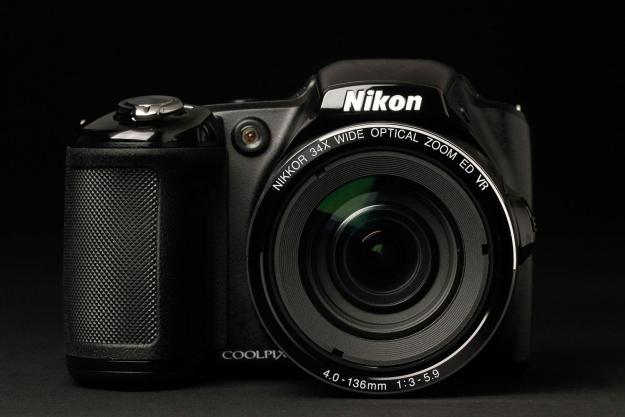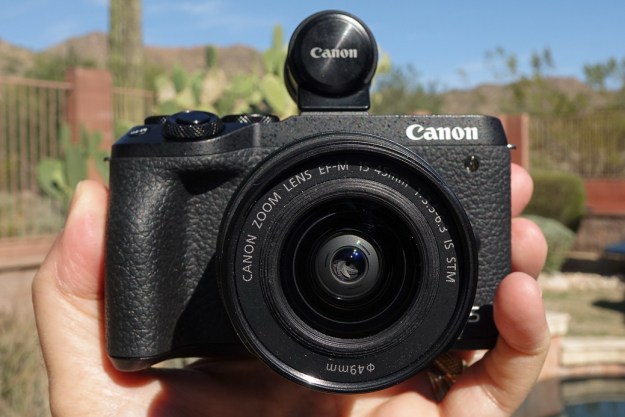
“As long as one is aware of its limitations, the Nikon Coolpix L830 should satisfy its intended customer – users looking for a super zoom camera on a budget.”
- 34x super zoom (22.5-765mm)
- 16 megapixels
- Quality stills/videos with enough light
- Small 1/2.3-inch imager
- Few manual adjustments
- No Wi-Fi
It’s not all gloom and doom in the camera world. Super zooms – those with 20x optical zooms or greater, also called ultra zooms or bridge cameras – are doing quite well versus smartphones with their decidedly inferior digital zooms. In reality, there is no comparison, photographically speaking. Nikon has given us a new “super” super zoom – the Coolpix L830 ($300) – with a whopping 34x spec, translating to 22.5-765mm! It’s not the longest-zoom you’ll find in such a camera, but it’s up there.
Features and design
Forget about slipping this one in your back pocket. Like all super zooms, the L830 is on the bulky side. In this case it measures 4.4 x 3 x 3.6, tipping the scales at slightly over a pound (18 ounces). Even so, we didn’t have many issues carrying it around and it fit in coat pockets fairly well. Our review sample was all black with a nicely textured grip, but red and plum body color options are available.
The key feature on the front is clearly the 34x Nikkor lens with decent maximum aperture ratings of f/3-5.9. At 22.5mm, it’s great for landscapes, and then you can zoom to the top of the Empire State Building or birds in the trees, whatever your heart desires.

The top deck has two items we really wanted to see – stereo mics. We recently knocked Canon and Nikon for offering new cameras with Full HD video capture, but with mono soundtracks. The L830 not only captures 1080/30p movies but has the requisite two-channel audio capability. Connect this camera via HDMI to your HDTV and you’ll enjoy a much more realistic experience. The videos have some other issues, which we’ll get to shortly.
Along with the mics, you’ll find a potent pop-up flash, a speaker, on/off button, and shutter button surrounded by a zoom toggle switch. For added stability, there’s also a wide/tele zoom lever on the left side of the lens. The grip is rather deep and our fingers fit well, but, as we always stress, try this one out in the camera shop to see if it fits comfortably in your hands. Since this is basically an aim-and-forget camera, there is no mode dial and few manual adjustments – there are no PASM options and you can’t adjust aperture/shutter speed. This may be a deal breaker for many but casual shutterbugs probably won’t care one bit. For advanced shooters, there’s always the Panasonic FZ200, Fujifilm S9400W, Sony RX10, and many others.
Despite its tiny chip, the L830 delivered on more occasions than not.
Note: Many super zooms have electronic viewfinders (EVF) that come in handy when you’re handholding the camera at extreme telephoto. The L830 is a sub-$300 camera so you can’t expect the sun, moon and stars. The tilting monitor is a real plus, however, since you can frame your subjects in more interesting perspectives.
Also on the back are a nicely textured thumb rest, a red-dot movie button, as well as four keys surrounding a four-way controller with center OK button. There’s a green dot button for changing the few modes available, and those for Playback, Menu, and Delete. The inner keys offer access to flash mode, exposure compensation, macro, and self-timer.
There’s a DC-in on the right side and the small compartment on the left has USB and HDMI connections. The bottom has a compartment for the four AA batteries and SD card. The L830 doesn’t offer Wi-Fi but it does accept optional Eye-Fi cards for network connections.
What’s in the box
You get the camera, strap, lens cap with cord, and USB cable. Nikon also supplies four alkaline batteries so you can start right away without waiting for a battery pack to charge up. Buying a set of lithium AAs makes sense, as you’ll have the ability to take 1,180 shots versus 390 for basic alkalines; you can also use rechargeable AA batteries, which gets you fewer shots than lithium but more than standard alkaline. Since AAs are available everywhere, you’ll never encounter the “OMG, my battery’s dead” scenario. The carton also contains a Quick Start Guide. To save some money, Nikon doesn’t include a software CD, but its ViewNX2 program is readily available via download.
Warranty
Nikon includes a one-year limited warranty, as well as an optional two-year extended services coverage. More information can be found here.
Performance and use
The Coolpix L830 is definitely a point-and-shoot when it comes to sensor size. It uses a 16-megapixel 1 /2.3-inch imager, which is far smaller than enthusiast 1/1.7-inch super zooms – both smaller than the ones found in interchangeable lens cameras with Micro Four Thirds and APS-C chips. Again, you get what you pay for. By way of comparison, the highly rated Sony RX10 with a 1-inch sensor is $1,000 more!
We set the camera to maximum resolution for stills (4606 x 3456) and movies (1080/30p). Rather than this reviewer’s usual Southwest locales we took the camera to the New York City area, which offers tremendous opportunities for a 765mm telephoto (see samples). Besides NYC buildings and street sculptures, we took the camera to the Jersey Shore, an historic plane exhibit, and a wedding with lots of opportunities for people shots. Weather was cloudy and rainy, with some sunshine thrown in – in other words, we threw a lot at the L830. We’ll state the camera did a good job with decent light, but not great. Asking a tiny chip to handle non-optimal light is like asking politicians to resolve the Federal budget crisis over a cup of coffee – it’s not happening. Yet, despite that inherent shortcoming, the L830 delivered on more occasions than not. Shots were crisp with good, realistic colors. People shots with the flash were among the highlights, as the face detection did a great job at the wedding and other social gatherings.
Besides Full HD video capture, it has something we want – stereo mics.
As mentioned earlier, the L830 is basically a point-and-shoot. Press the Green auto button and four options pop up: Auto, Smart Portrait, Special Effects (11 options), Scene (18 choices), and Easy Auto. In Auto you can adjust ISO, white balance, resolution, color options and AF area mode, but that’s it. Again, if you really want to tweak a camera’s settings, the L830 may not be for you, but we really didn’t feel shortchanged during our travels.
Movies taken by the L830 are uneven. It takes the camera a few seconds to adjust exposure properly and there are focusing issues in dim light. Again, that’s asking a tiny chip to do a lot. On the plus side there’s no sound from the lens mechanism as you zoom, and you’re capturing stereo audio. Like the stills, if you have enough sunshine, you’ll be in decent shape.
The L830 has an ISO range of 125-3,200, a mere fraction of the 12,800/25,600 of many 2014 models. But, given the sensor size, we were glad Nikon didn’t try to push it. Color was accurate and digital noise was kept under control at the ISO 400 level, with fairly good results at 800. From that point, noise became much more noticeable with strong color shifts at ISO 1,600 and beyond. Again, nothing you wouldn’t expect from a sub $300, small-chip point-and-shoot.
Conclusion
The Nikon Coolpix L830 has the stance of a more advanced camera, but in reality it is a good point and shoot with a super-zoom lens – good for casual photographers who want something more than a basic compact or smartphone, but unimpressive to anyone who’s used something stronger. But, at $300, that’s the point – it’s not trying to be something that will only be hindered by its small sensor. If you just want a point-and-shoot with a great focal range for your next vacation, the L830 will do the job. Just realize it has its limitations. Go in with your eyes wide-open, search for a good deal, and you’ll be pleasantly surprised.
Highs
- 34x super zoom (22.5-765mm)
- 16 megapixels
- Quality stills/videos with enough light
Lows
- Small 1/2.3-inch imager
- Few manual adjustments
- No Wi-Fi
Editors' Recommendations
- Nikon’s new 800mm lens for Z-mount cameras lightens the load
- The best point-and-shoot cameras
- Sony RX100 VII vs. ZV-1: How does Sony’s vlog-focused compact stack up?
- Nikon Coolpix P950 vs. P1000: Superzoom showdown
- Nikon D750 vs. D780: 5 years in the making, Nikon’s newest proves its worth










